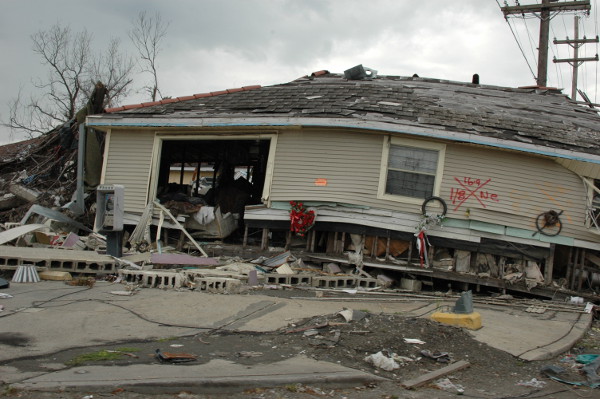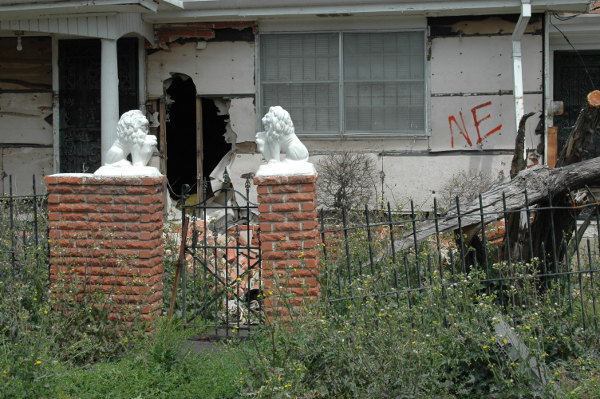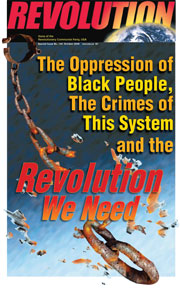After Katrina:
Driving Black People out of NOLA’s Lower 9th Ward
August 24, 2015 | Revolution Newspaper | revcom.us
In the years after Hurricane Katrina, many parts of New Orleans stayed like uninhabitable ghost towns, and the people who had been evacuated remained scattered all over the country, unable to go home. Tourist hotspots, the mainstay of the city’s economy, were quick to get up and running. But neighborhoods hard hit, especially poor Black areas like the Lower Ninth Ward, remained devastated. Whole areas were bulldozed, even though many, if not most, of the homes there were found to be sound, making it not even an option for people to come back to rebuild their homes.


Lower Ninth Ward, New Orleans, 2005. Photos: Revolution/revcom.us
Tens of thousands of families were put in 240-square-foot trailers that were later found to be toxic. People living in the trailers had complained that chemicals caused frequent nosebleeds, breathing difficulties, and mysterious mouth and nasal tumors. But when FEMA first got complaints about the trailers, they did nothing about it. After many months, FEMA tested a trailer, in March 2006, and found that the level of the toxic chemical formaldehyde was 75 times the government-recommended level for workplaces.
There was little effort by the government or private companies to rebuild homes in poor neighborhoods—there was no profit to be made there. Meanwhile, capitalists saw opportunity in the destruction and misery, to grab land and cash in on the most valuable resource in New Orleans—not the people, the rich culture, or the historical significance of the city—but in oil and natural gas.
People who wanted to go back to New Orleans had major obstacles to overcome. For example, in the Lower Ninth Ward there was no drinking water for 14 months and there was a lack of all kinds of social services in the city—hospitals, schools, and childcare facilities remained closed. Even though there was obviously lots to do to restore the city, there were few jobs for people who wanted to go back.
Even where there was cleanup and reconstruction, there was the ugly mark of capitalist exploitation. Much of this was done by immigrant Latinos, 80 percent according to one study; many were hired on terms that were little different than indentured servitude. Many of these workers reported that they were forced to work long hours with little rest and extremely low pay, crammed into small living quarters. Many said they were cheated out of pay and some employers, after they’d used and abused undocumented immigrant workers, turned them over to immigration authorities.
In 2010, five years after the storm, the rebuilding rates in different neighborhoods reflected the racial and economic divide in the city. Lakeview and the Lower Ninth Ward were the two neighborhoods hit the hardest. In Lakeview, a predominately white, upper middle class neighborhood, 59 percent of residents had returned. In the Lower Ninth Ward, a neighborhood that was 99 percent Black before the storm, only 24 percent of residents had returned.
After Katrina, the George W. Bush administration cut $71 million in federal social service funding to New Orleans—justifying this by saying the city now had a smaller population. In addition to people losing their homes in the storm, these cutbacks contributed to a big rise in homelessness. In 2008, one in 25 people in New Orleans was homeless—four times the average rate in the country and twice the rate in the city before the storm.
Many who lived in public housing faced the fact that the government had a plan to destroy their homes—part of a bigger plan for post-Katrina New Orleans that amounted to ethnic cleansing.
At the time of the storm, more than 5,000 families, almost all African-American, were living in New Orleans public housing. There were 8,250 names on the waiting list for public housing. But after the storm, for years, much of the public housing remained closed, and in the face of the worst affordable housing shortage in New Orleans since the end of the Civil War, the federal government made plans to bulldoze 5,000 apartments.
The Christian fascist wing of the ruling class openly voiced their program for the Black masses in New Orleans—which they attributed to god, but which was also quite in line with what the government had in mind. After Katrina, Louisiana Congressman Richard Baker said: “We finally cleaned up public housing in New Orleans. We couldn’t do it, but God did it.”
Other officials openly stated that they saw the future of New Orleans as a city that would be smaller and less Black. Before Hurricane Katrina, Black people made up about 70 percent of the population of New Orleans. On September 29, 2005, in an interview with the Houston Chronicle, Bush’s Secretary of Housing and Urban Development Alphonso Jackson predicted that the rebuilt city would be only 35-40 percent Black and said: “New Orleans is not going to be as Black as it was for a long time, if ever again.”
Volunteers Needed... for revcom.us and Revolution
If you like this article, subscribe, donate to and sustain Revolution newspaper.







